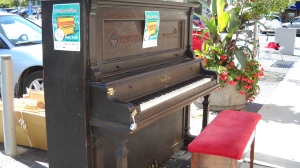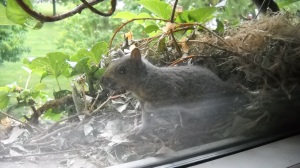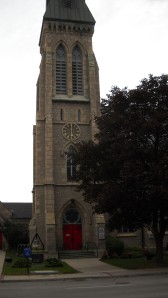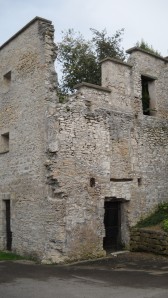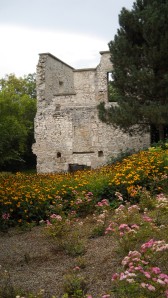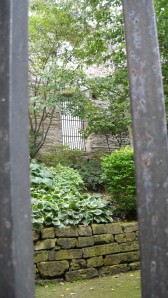There’s something both organic and artsy about this town — with caveats on both counts.
This town, of course, is Guelph, Ontario, where I’ve moved this month.
Have lived all my life 45 minutes’ drive down the highway in Hamilton on Lake Ontario. But I’ve had a foot in Guelph for much of my life, starting with my undergrad degree begun in 1980. Fifteen years ago, I returned to my alma mater as a writer. Been there since — more or less — but always commuting from Hamilton.
Now living on the Second Storey here just five minutes’ walk from downtown Guelph. Today I walked that five minutes’ distance to see what I might see and learn about my new-old home in a morning. It turned out to be less about learning and more about reinforcing and questioning.
Organic. Crowds attracted to the Saturday morning Guelph Farmers’ Market. Today special as the market has relocated to its original home near City Hall and Carden Street after a hiatus elsewhere.
Having been a former patron of the farmers’ market in my hometown Hamilton, I know that you have to be careful when you throw around words like “organic.”
Some claims to organic growing are apparently just so much goat manure. Organic certification appears to be the safest bet, ensuring things like no pesticides, no chemical fertilizers, no mechanized vehicles and so on.
Even the term “farmers’ market” is a loose one. In some places, there are fewer true farmers and more vendors whose goods have been trucked in from the nearest food terminal.
A few signs among the stalls in Guelph today proclaimed “No pesticides” and “Pesticide-free.” One apple grower uses integrated pest management in the orchard. “Organic” appears in the names of at least a couple of vendor stalls.
You can find organic choices in the supermarket, of course. Speaking of supermarkets, city council this week approved rezoning in the ever-growing south end of Guelph for a new Sobeys.
Good news for shoppers in that part of the world looking for more choices period, organic or not. Not much consolation for a colleague in the east end of town who has lobbied for a grocery store there since she moved to the area about three years ago.
She perceives Guelph as “anti-development.” Too many building restrictions. Just look at the bylaws in Guelph that prevent developers from obstructing sightlines to the Church of Our Lady and from out-elevating the city landmark. There it is on the skyline in the above picture.
Myself, I appreciate the architecture downtown. And you can`t help liking a place that pays attention to its built heritage, let alone seemingly esoteric things like sightlines. I come from Hamilton, remember, where sometimes it seems people would sooner knock down a heritage building than look twice at it.
Most supermarkets are tidy low-rise affairs. Maybe there’s a way to place a new supermarket on the most easterly outskirts of the east end, where the only thing it might obstruct would be any possible view of Toronto.
My colleague and I also shared some thoughts about the arts community here in the Royal City.
(By the way, the city was named to honour King George IV, whose family name was Gwelf. It was established in 1827 as a base for the Canada Company by superintendent John Galt, a Scottish novelist. Its radial street and grid system was patterned after European town centres, radiating outward from a spot on the Speed River downtown near Galt’s original home.)
Having worked and half-lived here for a while, I’ve always considered this university town as an artsy place, one where arts and culture are intertwined. Everyone seems to know everyone else, maybe not surprising in a city of some 120,000 souls. It’s not six degrees of separation here. Maybe one and a half. Be careful what you say about people here, I’ve been warned.
Within that, the arts crowd has always seemed especially tight. Indeed, there are overlapping circles. Go to one place or event, or talk about one artist, and you can almost see the lines glowing to connect them to everyone else.
At the same time, there can be a disconnect. My same colleague moved here three years ago and says she’s had a tough time integrating with the community, let alone the artistic crowd. Just try breaking in when you’ve come from outside without knowing a soul, she said.
One artist I met downtown this morning for the first time acknowledged the closeness of the arts community here, but also spoke of “layers.” Not everyone necessarily knows or appreciates others.
We might be talking about different issues here. Who ever said artists ever claimed to agree with one another — a different issue from knowing one another or acknowledging one another’s presence?
I plan to look into these questions here and elsewhere. Arts do indeed help to define this town — and offer a way in for someone like me who’s been half-in all along.
My own stroll downtown this morning gives me reason for optimism. After visiting the market, I walked a few blocks to a new arts/music space just down the street called Silence. Funny enough, when I learned of its existence this week, I polled three co-workers: none had heard of it. Silence indeed.
Maybe I have a leg up already. More optimism: I ran into several acquaintances from the university campus where I work. So not alone.
And then there was this, spotted on Carden Street this morning, one of about 10 similar instruments parked around town this month and free for the plunking. Things can’t be all bad in a place where they invite you to share your musical soul, more or less on the spot.


